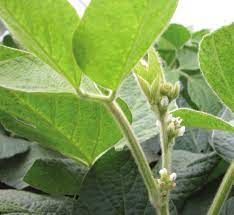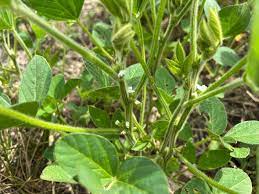Soybean petioles are slender, elongated structures that serve as the main connection between the soybean plant’s stem and its compound leaves. A petiole can be thought of as the “stalk” that attaches a leaf to the main stem. It acts as a conduit, allowing essential nutrients, water, and minerals to flow between the leaf and the rest of the plant.
Soybean petioles can vary in length depending on the plant’s growth stage, environmental conditions, and specific soybean variety. They typically range from a few inches to several inches in length. Petioles are generally slender and cylindrical in shape.
The color of soybean petioles can range from green to reddish-purple, with the color often changing as the plant matures. The texture is usually smooth, though some variations in surface texture might be observed due to factors such as waxy coatings or fine hairs. The petioles attach to the stem at nodes, which are points on the stem where leaves, branches, or other structures are connected. These nodes are crucial as they provide support and allow for nutrient and water transport.
The primary role of the soybean petiole is to transport water, nutrients, and photosynthates (sugars produced through photosynthesis) between the leaves and the rest of the plant. This transport is essential for the growth and development of the soybean plant.
Soybean petioles play a vital role in the overall health and growth of the soybean plant. They facilitate the exchange of materials between the leaves and the rest of the plant, supporting processes like photosynthesis, nutrient uptake, and water transport.
The Economic Importance and Uses of Soybean Petioles

Soybean petioles are the slender stalks that connect the soybean leaflets to the main stem. While soybean petioles might not be as commonly recognized as some other parts of the soybean plant, they do have certain economic importance and uses.
Here are some of them:
1. Livestock Feed: Soybean petioles can be used as a source of forage for livestock. They contain some nutritional value and can be included in the diet of ruminant animals like cattle and goats. However, their nutritional content is generally lower compared to other parts of the soybean plant, like the leaves and stems.
2. Organic Matter and Soil Improvement: After harvest, soybean petioles can be returned to the field as organic matter. As they decompose, they contribute to soil fertility and structure. Organic matter enhances water retention, nutrient availability, and microbial activity in the soil, leading to improved crop growth over time.
3. Mulching and Weed Suppression: Soybean petioles can be used as mulch in agricultural fields. Mulching helps to suppress weed growth by blocking sunlight and creating a physical barrier. As soybean petioles break down, they release nutrients into the soil, providing a dual benefit of weed suppression and soil enrichment.
4. Research and Study: Soybean petioles can be valuable in research and studies related to plant physiology, genetics, and agronomy. They are often used in laboratory experiments to understand various aspects of plant growth, nutrient uptake, and stress responses.
Read Also: SoyBeans – It’s Importance and Health Benefits
5. Composting Material: Soybean petioles can be included in composting processes, contributing to the production of nutrient-rich compost. Compost can be used to enrich soil in gardens, landscaping, and agricultural fields, promoting healthier plant growth.
6. Biorefinery and Bioenergy: While soybean petioles are not as widely used as some other biomass sources, they can potentially be processed in biorefineries to extract valuable compounds. These compounds could include lignocellulosic materials that can be converted into biofuels, biochemicals, or other industrial products.
7. Sustainable Farming Practices: Using soybean petioles as a part of sustainable farming practices aligns with the principles of agroecology and reduces waste in agricultural systems. By incorporating different plant parts into the farming cycle, farmers can minimize resource waste and maximize resource use efficiency.
8. Crop Residue Management: Soybean petioles, along with other crop residues, play a role in conservation tillage and no-till farming systems. These practices involve leaving the previous crop’s residues on the field surface to protect the soil from erosion, improve water infiltration, and enhance overall soil health.
9. Carbon Sequestration: Soybean petioles, when incorporated into the soil or left as residue, contribute to carbon sequestration. This process helps mitigate climate change by capturing atmospheric carbon dioxide and storing it in the soil, reducing greenhouse gas emissions.
10. Local Industry and Craftsmanship: In some regions, soybean petioles or other plant materials might be used for local crafts and industries. For example, they could be woven into baskets, mats, or other traditional products, supporting local economies and preserving cultural practices.
11. Environmental Restoration: In environmental restoration projects, soybean petioles can be used for erosion control and habitat restoration. They can help stabilize soil in areas affected by erosion, contribute to habitat creation, and assist in re-establishing native vegetation.
12. Biodegradable Materials: Soybean petioles and other agricultural residues can potentially be used in the development of biodegradable materials and packaging. As the demand for sustainable and eco-friendly materials increases, researchers are exploring ways to convert agricultural waste into valuable products.
13. Nutrient Cycling and Cover Crops: Incorporating soybean petioles into the soil can contribute to nutrient cycling in the ecosystem. When used as part of cover crops or green manure, they can improve soil fertility, suppress weeds, and prevent nutrient leaching.
14. Educational Purposes: Soybean petioles can be used as educational tools to teach students and the public about plant anatomy, agriculture, and sustainability. They can be especially useful in teaching about plant growth and different plant parts.
The Products and By-products That Can Be Derived From Soybean Petioles

Soybean petioles are the slender stalks that connect the leaf blades to the main stem of the soybean plant. While soybean petioles are not commonly utilized in the same way as soybeans themselves, they do contain various components that can potentially be utilized for different purposes. However, it’s worth noting that the utilization of soybean petioles is not as widespread as other parts of the plant.
Here are some potential products and by-products that can be derived from soybean petioles:
1. Fiber and Cellulose Materials: Soybean petioles contain cellulose and lignin, which can be extracted to create fiber-based materials. These materials can be used for making paper, textiles, and even certain types of bio-based plastics.
2. Biofuel Production: The cellulose and hemicellulose present in soybean petioles can be converted into biofuels through various processes such as enzymatic hydrolysis and fermentation. The resulting biofuels, such as ethanol, could be used for energy production.
3. Animal Feed: While soybean petioles may not be as nutritious as soybean seeds, they still contain some nutrients and fiber. They can be used as a supplemental feed source for livestock, contributing to their diet’s fiber content.
4. Mulching and Organic Matter: Soybean petioles can be chopped or shredded and used as mulch in agriculture. As they decompose, they contribute organic matter to the soil, enhancing its structure and nutrient content.
5. Composting: Petioles can be composted to produce nutrient-rich organic compost, which can then be used as a natural fertilizer to enrich soil for plant growth.
6. Biodegradable Products: Cellulose from soybean petioles can be used in the production of biodegradable products like packaging materials, disposable utensils, and single-use containers, offering an eco-friendly alternative to traditional plastics.
Read Also: Soybean Stems: Economic Importance, Uses and By-Products
7. Phytoremediation: Soybean plants, including their petioles, have been used for phytoremediation purposes. They can absorb and accumulate heavy metals and other pollutants from the soil, helping to clean up contaminated environments.
8. Biorefinery Feedstock: Soybean petioles can serve as a potential feedstock in biorefineries, where various bio-based products are produced through different biochemical and chemical processes.
9. Research and Innovations: Soybean petioles can be used for research purposes, such as studying plant physiology, cellulose chemistry, and bioconversion processes. This research could lead to innovative uses and applications for this plant component.
In conclusion, while soybean petioles might not be a primary economic driver in the soybean industry, their potential uses align with principles of sustainability, resource utilization, and waste reduction. As agricultural practices continue to evolve and prioritize environmental stewardship, finding innovative ways to utilize different parts of crops like soybeans, including petioles, can contribute to more efficient and resilient agricultural systems.
